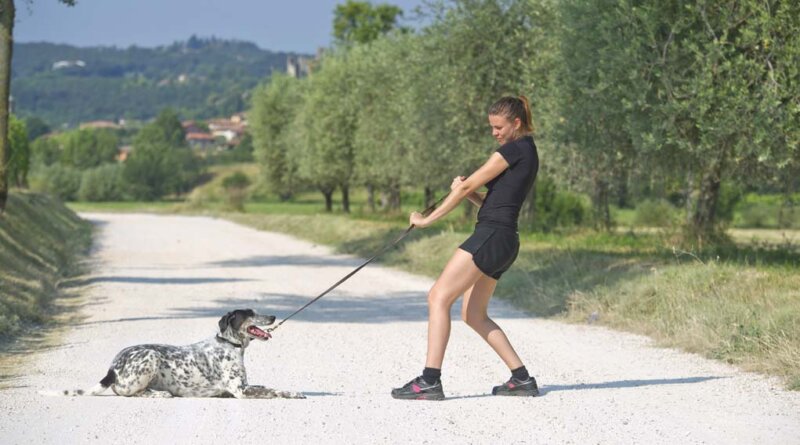How No-Pull Dog Harnesses and Collars Help with Dog Leash Pulling
Dog leash pulling is a common behavioral issue that needs to be fixed. Certain tools can be not only helpful but even essential so as to prevent injuries to both the dog and the owner.
Studies demonstrated that dog leash pulling is a serious safety hazard (1). What makes this behavioral problem worse is using the wrong walking equipment, such as a regular dog leash and collar combo.
Generally, no-pull dog harnesses are recommended for pulling dogs. While they’re more expensive than a collar, they are also far safer. So how exactly do no-pull harnesses for dogs help, and what do you need to know about leash pulling in dogs?
What We Know About Leash Pulling
One extensive study showed how to leash pulling causes danger to dogs and people walking them, as demonstrated in one study (2).
Other studies suggest that leash pulling may result in high blood pressure flowing into the dogs’ eyes causing eye problems, and potentially broken trachea and/or larynx (3).
Dog trainers and medical professionals also warn owners that puppies that are not properly leash trained will turn into adult dogs that pull incessantly on their leashes, thereby continuing this misbehavior.
This can be a major issue with strong medium or large breeds that can drag the owner behind them.
Big dogs can weigh upwards of 60+ pounds and have serious power, which results in safety hazards when the dog decides to take off suddenly.
To fix leash pulling, some owners tried negative punishment, which was shown to be ineffective (4).
Positive punishment was also shown to have little to no effect on changing this behavioral problem in dogs (5).
Finally, shouting at the dog and other similar methods did not fix leash pulling either (6).
Other studies demonstrate that tools such as no-pull harnesses which serve as disruptive stimuli work better with dogs that pull a lot (7).
Compared to negative or positive punishment methods, using a no pull dog harness simply serves as an “undesirable event” for the dog, which eventually leads the animal to change its course of action towards a more desirable behavior (8).
Skip the Regular Dog Collar
Dogs that pull incessantly cannot wear regular collars.
These collars are ineffective for training or walking dogs with inappropriate behavior and may result in injuries for both the dog and the owner.
Research shows that even in regular settings, dog collars put too much pressure on the dog’s neck, trachea, and larynx than a dog harness does (9). The dangers are increased with dogs who have serious leash pulling problems.
Moreover, not only do collars cause pain and injuries, but they’re also easy for the dog to slip out of, as well as allowing the dog to easily drag the owner all over the place.
And although dogs do in fact feel pain, they do not always comprehend the fact that they are hurting themselves or place the owner in danger.
Avoid Prong and Choke Collars
As someone who’s been teaching people about dog training, I’ve seen dog owners try different methods. Aside from negative punishment, some choose to use choke collars or prong collars for dogs that pull on the leash.
Others opt for shock collars and other methods that may cause a certain level of pain.
These are far from ideal solutions and rarely result in what the owners try to achieve (10).
Dog trainers and other animal experts agree that using either of these collar types may hurt the dog, both physically and mentally.
Pairing that with the evidence of them being ineffective means it’s best to dismiss these types of collars altogether.
Dog Training and No Pull Harnesses
With the above in mind, it appears that no-pull dog products like harnesses or no-pull collars are the best solutions we have.
No pull dog harnesses are also becoming the most often bought product in the dog supplies category regardless if the dog is a puller or not.
That said, even though a no pull dog harness is the safest and easiest way to stop a dog from pulling on a leash – and definitely better than prong, choke or shock collars – remember that leash pulling training cannot be avoided.
A no-pull dog harness only serves as a temporary solution and simple aid while you’re training the dog to stop pulling.
If you decide to start training your dog to not pull on the leash, you’ll have to get either one of the two tools: dog head collar or dog front clip harness, which is essentially a so-called “no pull dog harness.”
These safe dog training tools have been shown to work well for training dogs to stop pulling on the leash without harming them.
However, keep in mind that it’s very important to get the right stuff that you can trust will not hurt your pooch.
No-Pull Dog Head Collars
Head dog collars are one of the best ways to teach your dog to mind you when they are on a leash. Do not mistake these collars for muzzles.
Although they do go around the dog’s snout – sort of like an open-muzzle – dogs are still able to open their mouths, pick things up, drink, and eat when the head collar is on.
In the photo to the right, you can see what a dog head collar looks like. You can find more of them on Amazon and browse through their description for details. They’re also not very expensive, so most owners can buy them as a temporary solution and stop using them when the time is right.
These collars for dogs may not look “good” on your pooch, but if you’re having problems with your pet pulling on the leash, this cannot be avoided. Plus, it’s only temporary, so when you get a stare from another dog owner in the park, pretend you’re about to unleash your fierce beast on them that is your Yorkie. Not really.
Dog head collars allow the dog walker to attach the dog leash to the strap around the canine’s muzzle and lead them in the direction they want the dog to go instead of pulling on the dog’s neck like a basic collar would. This removes all the unnecessary strain, even though it may not look as attractive as a harness.
Multiple dog trainers agree that dog head collars work well for “determined pullers.” They’re also safe for dogs, as long as you use them the right way.
When your dog pulls on the leash, the strap around the muzzle will put pressure on a point that triggers your pooch to relax immediately. Because pressure is only applied when the dog pulls, your pet will begin to realize that he is the one in control of the pressure.
A word of caution. Although dog head collars are excellent for dogs that pull, they also take some time for the dog to get used to, and therefore do require a little bit of leash training using the proper dog leash that fits them. You must prepare and train for this before you and your pooch are able to a dog head collar on a daily basis.
Front Clip/No-Pull Dog Harnesses
More and more dog owners are switching to using dog harnesses over regular collars and simple dog leashes, even when there are no issues with pulling. This makes sense for multiple reasons.
Not only does using really good dog harnesses with a front clip prevent any injuries from your dog pulling, it’s also generally safer in many other potential scenarios. It even looks better and more humane on a dog, or so I have been complimented.
What you see to the right is that type of dog harness, made by Ruffwear – a company with a great reputation.
I personally love their products, and their dog harness is by far the best quality you can get.
However, it is one of the more expensive ones on the market.
Many dog companies are now focused on manufacturing different types of front clip/no-pull dog harnesses and other similar devices that help owners to deal with leash pulling, which is a very common issue. If the Ruffwear is too expensive, there are plenty of other choices for no-pull harnesses here that cost about half the price.
As most of you know, there are several types of dog harnesses out there, and not all of them work in the same way or help the same cause. Not all of them also work for the same types of dogs. A lot depends on your pet’s breed, size, age, and temperament.
When discussing dog harnesses, many imagine that step-in harnesses for dogs allow the walker to clip the leash between the dog’s shoulder blades.
While these may be good for walking dogs in general, if you have an issue with your dog pulling on the leash, then these harnesses are not for you.
In fact, these dog harnesses encourage pulling.
So my advice is to stick with one of the two options we discussed above.
Take-Home Message

Front clip no pull dog harness will allow you to clip the dog leash directly to it in the middle of the dog’s chest, thereby providing perfect balance when there are stimuli.
Also, this way there are two straps applying pressure to the dog’s chest at the time of pulling, and it’s also easier for the owner to train the dog to stop pulling permanently using a no pull dog harness.
To put the final nail into the coffin, front clip dog harnesses are more easily accepted by the dog, by the pet-loving community and there’s a lot less training required to start using them effectively. Finally, they just look so damn good!
So if you’re thinking about whether to go with a dog head collar or a front clip harness, then go with the latter.
Most importantly, please do not use any other tools that may hurt your dog or you as well as prevent you from effectively training your pet to stop pulling once and for all. These trial and error methods have already been done by other dog owners – they don’t work (please see studies above).
If you want some advice on training dogs using front-clip dog harnesses, I recommend you reading some of these articles (I also linked to these above in the article):
READ NEXT: How To Train A Dog To Walk On A Leash
Want to share this?
Related








best pills for ed https://edpill.cheap/ erection pills that work